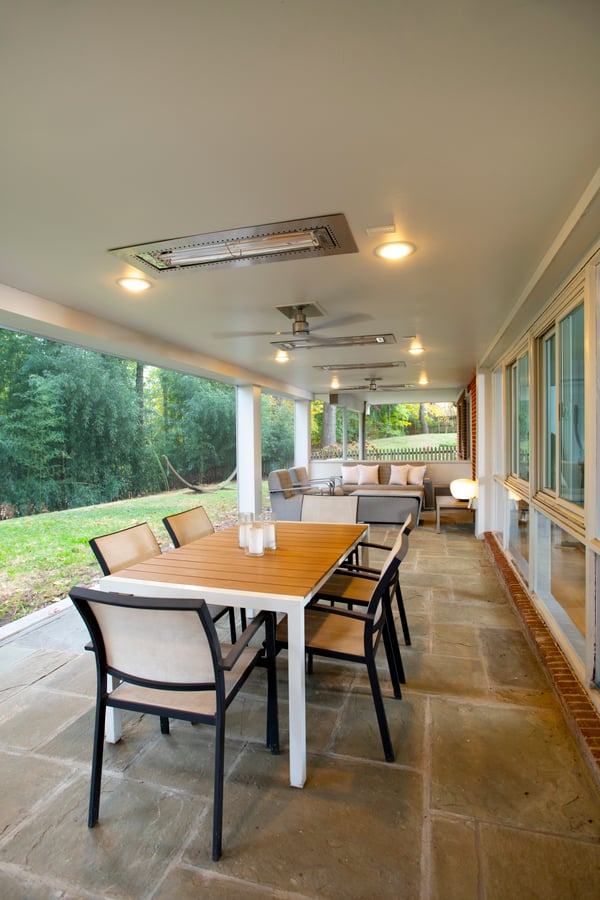When the weather turns cold and icy gusts of wind howl in the backyard, many screened-in porches fall to neglect. It’s understandable — screened porches may shield inhabitants from bright sun, cool rain, and pesky insects, but they provide little protection from chilly air and cold wind. This can come as a disappointment to homeowners who had been hoping to use their screened porch during parties and get-togethers over the holidays or football season.
So what options do homeowners have for extending the life of their screen porch beyond the warm summer months? Both gas and natural wood fireplaces can be attractive options, but they’re also pricey – typically costing in the $10,000-$15,000 area price range.
If you are a homeowner hoping to enjoy the comfort of your screened porch long into the colder months, a more efficient and economical solution may be to install infrared heaters.
What Are Infrared Heaters and How Do They Work?
Infrared heaters are a unique warming system that transfers heat directly to people and furniture, rather than heating the air. Heated quartz elements within these types of heaters emit rays that are absorbed by other items, evenly distributing heat to surroundings. When it comes to screened porch heating systems, infrared heaters offer many benefits over fireplaces and traditional space heaters, including:
- Efficient heating. While traditional heaters are rendered ineffective by drafty conditions, infrared heaters emit a radiant energy that won’t be blown away in the wind. For this reason, infrared heat is one of the most effective ways to heat a screened porch, patio, or any other setting where warmth cannot be contained and re-circulated efficiently
- Environmentally friendly. Unlike gas heaters and fireplaces, infrared heaters do not emit carbon monoxide, other hazardous greenhouse emissions, or odors. Rather, infrared heating systems release a radiant heat that does not harm the environment and is safe for both indoor and outdoor usage
- Easy on the eyes. While halogen and short-wave heaters often emit harsh light, infrared heaters give off a glow that is nearly invisible to the naked eye. This invisible light is absorbed by skin, clothing, and other objects, warming them in a safe and gentle way
- Cost effective. Many types of infrared heaters convert more than 90 percent of input energy into heat, making them a cost-effective and energy-efficient alternative to older brands of space heaters
What Type of Infrared Heater Is Right for My Screened Porch?
Before installing an infrared heating system in your screened porch, there are several factors to consider.
- Size. If your screened porch is relatively tiny, a small, single-element heater may be all you need. But if your space is larger, you may want to consider installing a larger-dual element model
- Number. A single space heater can typically provide heat for a 10x10-foot radius, but to heat larger spaces, multiple heaters may be necessary
- Location. You should be strategic about where you decide to install your infrared heaters, setting them up above or around seating areas where they are likely to get the most use
- Brand. While there are many different brands of infrared heaters to choose from, we recommend Infratech heaters, which are eco-friendly, energy-efficient, and come in a range of styles
Additional Components
Once you’ve chosen your product, there are three other components that will need to be included in your project.
- Relay box. Control options for your heating system range from simple on and off-switches to advanced solid-state control systems
- Timer. It’s important to include a timer in your system to ensure you don’t leave the heater on by mistake, wasting energy and money
- Circuit. Each individual heater will require its own large circuit, so if there’s not enough room in your circuit box, you may need to upgrade
Total Costs
The total cost of installing an infrared heating system for your screened porch will typically be around $2,500 per heater. The overall cost may be affected if you need to upgrade your circuit box or repair drywall for the project. Similarly, if the circuit box is far from your screened porch, the installation fee may increase as well.
Questions? Feel free to reach out to us at any time!

.jpg?width=800&name=MaidenLaneBethesda_0050%20(2).jpg)


